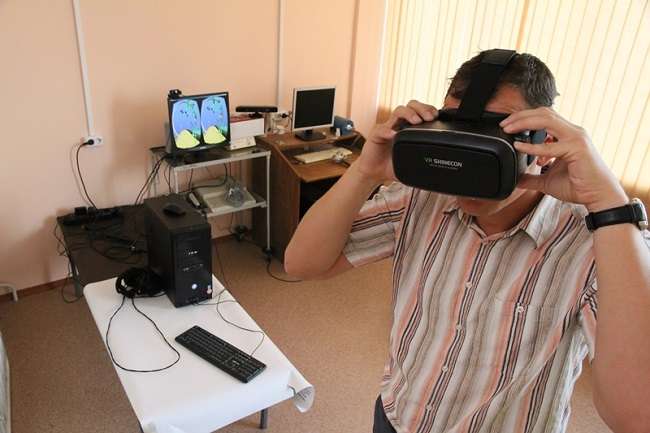Virtually reality simplifies early diagnosis of multiple sclerosis and Parkinson's disease

Scientists from Tomsk Polytechnic University and Siberian State Medical University are developing an early diagnosis system for neurodegenerative disorders. The system is intended for such diseases as multiple sclerosis, Parkinson's disease and others. The diagnosis system is based on virtual reality (VR) – a patient is immersed in a virtual environment to carry out some functional tests. Researchers vary the parameters of the virtual environment and record changes in the person's movements. The scientists expect to complete the technical part of the project in 2017.
The diagnosis system for neurodegenerative diseases is a joint project for scientists from Tomsk Polytechnic University and Siberian State Medical University. The project involves eight people – scientists, postgraduate and graduate students of the universities.
The system being developed by TPU and SSMU scientists consists of augmented reality glasses, a non-contact sensor controller and a mobile platform.
The developers use existing devices such as Google augmented glasses and Kinect sensor system. Diagnosis is as follows: A person puts the glasses on and enters a virtual reality with an adjustable slope. The motion sensor detects changes in posture. A person without disorders quickly adapts to the virtual environment and keeps a stable position; a person with disorders can't adapt and loses balance.
"We have integrated existing devices and developed mathematical models for data analysis. We have also created a human skeleton model, identified 20 important points that Kinect monitors. Diagnosis provides results of deviations in the 20 points," says David Khachaturyan, a scientist from TPU.
The system has been already tested by about 50 volunteers.
"In the experiment, we tested how VR influences people. The procedure took almost 10 minutes. The experiment engaged both healthy people and those whom doctors had already diagnosed. Currently, we can't say if a person is healthy or not, or make a diagnosis. But thanks to the system, we can say how much a patient's condition differs from a healthy person's. We have also found out how people with different diseases react to a virtual environment. For instance, people with Parkinson's disease exhibit hand tremors," says Ivan Tolmachov.
To complete the technical part of the project will take one more year. Then the system will pass clinical trials and required technical and toxicological certification.
"In the future, the system will be used not only for disease diagnosis but for patient rehabilitation as well," adds the scientist.
"Our sense of balance and our movement are controlled with a number of systems. This is the vestibular apparatus – the inner ear and semicircular ducts – which determines our position in space and the direction of gravity. This also involves the muscular system and vision. All these coordinated systems operate automatically. They falter if a person gets a neurodegenerative disease like, for example, Parkinson's disease," says Ivan Tolmachov, senior instructor at the TPU Department of Industrial and Medical Electronics, associate professor at SSMU.
According to the scientists, in the case of Parkinson's disease, the cell death process can start at age of 30, but the symptoms of the disease will be noticeable only at 50.
Therefore, scientists around the world are seeking effective and affordable early diagnosis methods for neurodegenerative diseases.
"To feel a functional loss, a person should lose about 80 percent of related cells. But at that point, there is no path to recovery. Therefore, it is important to diagnosis the disease at earlier stages, when patient can still get help. Currently, physicians use pencil-and-paper tests to detect neurodegenerative diseases, but they are mostly based on visual assessment, and there is lack of instrumental and effective methods. PET scanning is available only in nine cities in Russia," says Ivan Tolmachov.
More information: Ivan Tolmachev et al. Sensory Dissociation in Vestibular Function Assessment, MATEC Web of Conferences (2016). DOI: 10.1051/matecconf/20164805005




















